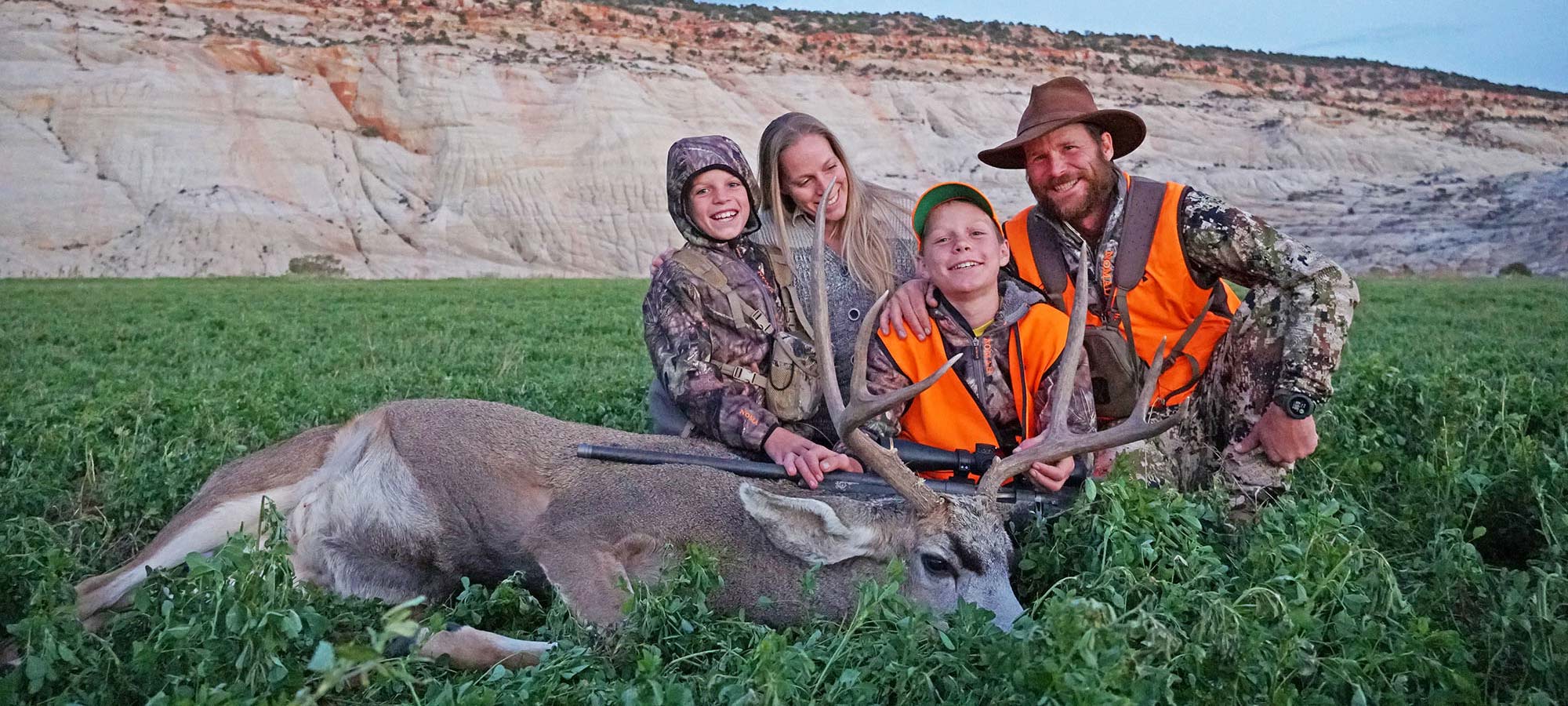We may earn revenue from the products available on this page and participate in affiliate programs. Learn More ›
I grew up in the remote badlands of southern Utah where you’ll find some of the finest mule deer genetics in the world. It’s where I shot my first deer, and my family continues to hunt here for our winter meat. High-country aspen leaves flutter and wave in the alpine country our local mule deer call home throughout spring, summer, and early fall. It’s tall country, and a good place to spend time during the early archery and muzzleloader seasons. If you hunt hard and are really lucky, you just might get a shot at a wide-racked buck. Even if you don’t, you’ll come away a better person for having stalked through the mountain meadows.
The first heavy storm of fall usually coincides with our October general elk hunt. This is when the deer turn toward lower, warmer, less pressured areas. The fields where I farm and raise cattle don’t see a deer track all summer, but come mid-October, you might spot one meandering across. Two days later you’ll see a healthy handful of tracks and nipped-off late-season alfalfa plants. After three days; the fields will be full of deer. It’s a sign the migration is happening, the deer are here, and hunting season is only a day away.
Public and private lands form an erratic patchwork quilt across the region. Old homestead properties are surrounded or bisected by BLM, hay fields are divided or edged by National Forest, and some public lands are surrounded by private ground (find onX Hunt’s project on landlocked public lands here). The deer use all the land without bias—on public ground one moment and private the next. To hunt them effectively, we have to know and respect the boundaries.
The objective of our hunts has always been the same: target mature bucks to fill our freezer with venison. But times have changed. These days there are fewer deer, it’s tougher to draw a tag, and there’s more conflict with the growing numbers of tourists and transplant neighbors.
The hunt always opens on a Saturday, and today, the preceding Friday, we’re abuzz with excitement while watching deer through spotting scopes and sorting our gear. We shoot our rifles one last time to verify our zeros. This year, as Outdoor Life executive editor Alex Robinson and I ride in my pre ’94 Dodge toward our shooting spot, there’s a parked SUV sporting a sign that reads “Earth Tours” on its side, and hikers are gamboling about the slickrock that forms our shooting backstop. I have shot rifles in this same spot since I was a kid, and I grind my teeth a little as we drive off to find somewhere else to shoot.
Southern Utah has become a mecca for nature lovers, hikers, and tourists. Wealthy second-home owners and retirees have driven agricultural land prices beyond any affordable margin, and their homes be-speckle what used to be productive pastures and hayfields. I can’t fault them. The place is extraordinarily beautiful. But, there are heavy consequences for these new developments. The salt-of-the-earth farmers and ranchers who were stewards of this land are migrating away, and there’s less habitat for mule deer. Dwindling deer numbers and burgeoning human populations create a supply and demand misbalance. Nowadays, our family deer hunt only happens every three years or so, because that’s how often we can draw buck tags.
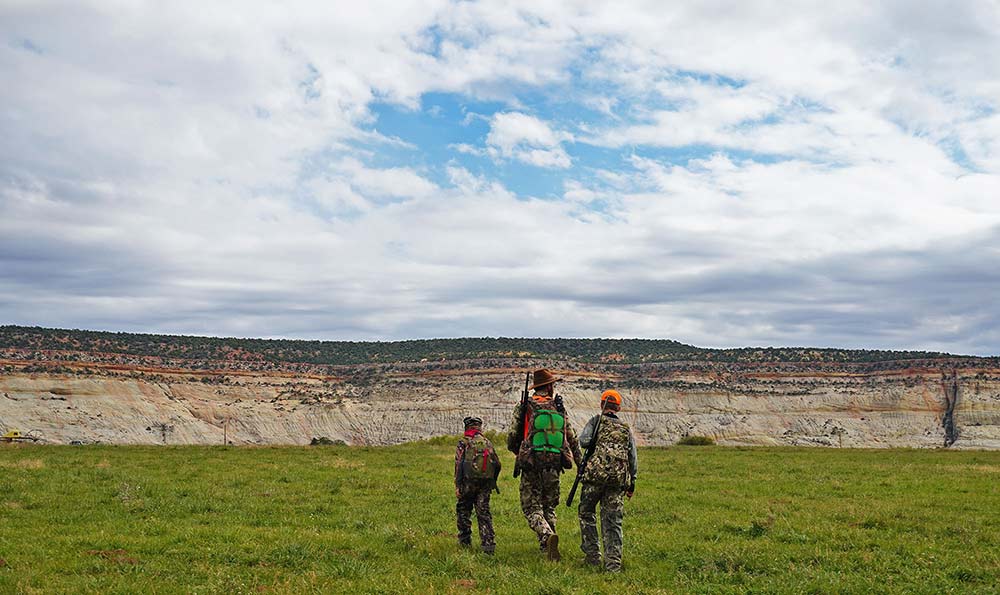
On a positive note, when we do draw tags the hunting is great, largely because of reduced pressure from other hunters and the fact that our farm fields are lush and attractive. This year my family was fortunate enough to draw tags all around (well, almost; my daughter filled her grandfather’s tag under the Utah hunter mentor program). Additionally, this year will be my 12-year-old son Ivan’s first big-game hunt.
As dusk falls, and darkness obscures the badlands, we complete our preparations, eat a good home-cooked meal, and finalize our strategies for the morning. Opening day is upon us. —A.V.B.
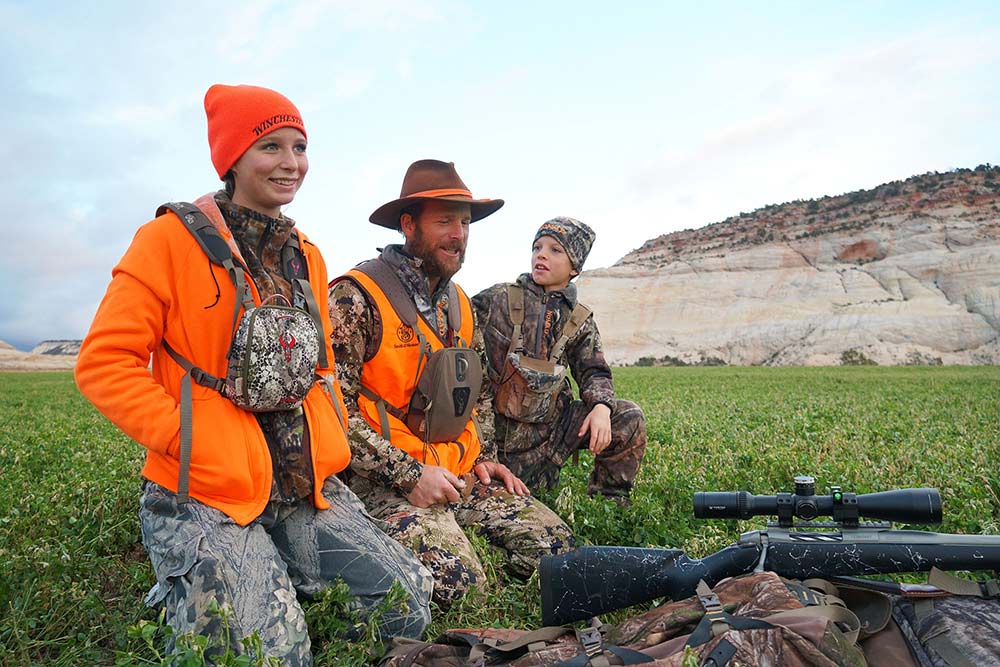
Ivan’s Buck
Several miles of basalt badlands lay in the darkness behind us, and ahead of us is a patchwork of alfalfa fields filled with mule deer. Our shoulders are chilled and damp where our pack straps induced sweat, so we quietly slip into our coats. It’s opening morning, and the deer are leaving the fields and heading our way.
Ivan has the first shot this morning. In Utah, young hunters must be at least 12 before they can hunt big game, so this is Ivan’s first-ever big game hunt. As the sun peeks over the eastern horizon, I watch him and his younger brother Josiah glass deer in the field below us. Ivan is tall for his age, and very intelligent. Hunting has never really appealed to Ivan, which is hard for me to understand. He is a responsible and hard-working boy, and he’s doing this hunt mostly for me, knowing I would be disappointed if he elected not to hunt. I hope I can turn the experience into something that he’ll enjoy, and that maybe it will kindle a desire in him to hunt in the future.
The early dawn light reveals a band of bucks browsing through distant sagebrush. They head into a small draw, out of sight and away from our position. It’s time to move. We circle back over the ridge and out of sight, and then hoof it through the pinyon and juniper forest; crossing near the area where I killed my first buck several decades before. The hunting grounds of one’s youth are forever special, and this territory is one of my favorite places on earth.
Twenty minutes later we sit atop another boulder-strewn point, watching our band of bucks move through a thicket. They are on private land that we can’t hunt, so we relax in the early sunshine, snapping photos and shooting video of the deer, hoping they move onto land we can access. Eventually they do just that, and we begin our stalk, working toward a good shooting position. The opportunity comes quickly and Ivan gets prone in the sand, drawing a bead on the biggest buck as it hurries toward the top of a ridge. One small opening in the trees remains, and as the buck steps into it, I blow a deer call. The buck stops. I forget to remind Ivan to squeeze the trigger, and instead just say, “Shoot him.” There’s an eruption and the deer leaps and disappears over the ridge with only a few hairs shaved off the back of his neck.
Disappointment clouds the morning, but I try to reassure Ivan that it’s okay, and to use the opportunity as a learning experience.
That evening, we’re all tired from the rough miles hiked through the badlands, so we decide to hunt an alfalfa field where we saw a big 3×3 buck the night before. As we approach the field, deer are already out feeding, so we crawl toward a rise in the ground to find a good shooting position. Sure enough, our big buck is out there. Its antlers are wide and impressive as he quarters toward us in the evening light. Ivan settles in a prone position again with his rifle resting atop my backpack. I remind him to squeeze the trigger. The buck drops in its tracks. Ivan learned his lesson from earlier today, and he makes a good one-shot kill. I’m not sure who’s more pleased, Ivan, or myself.
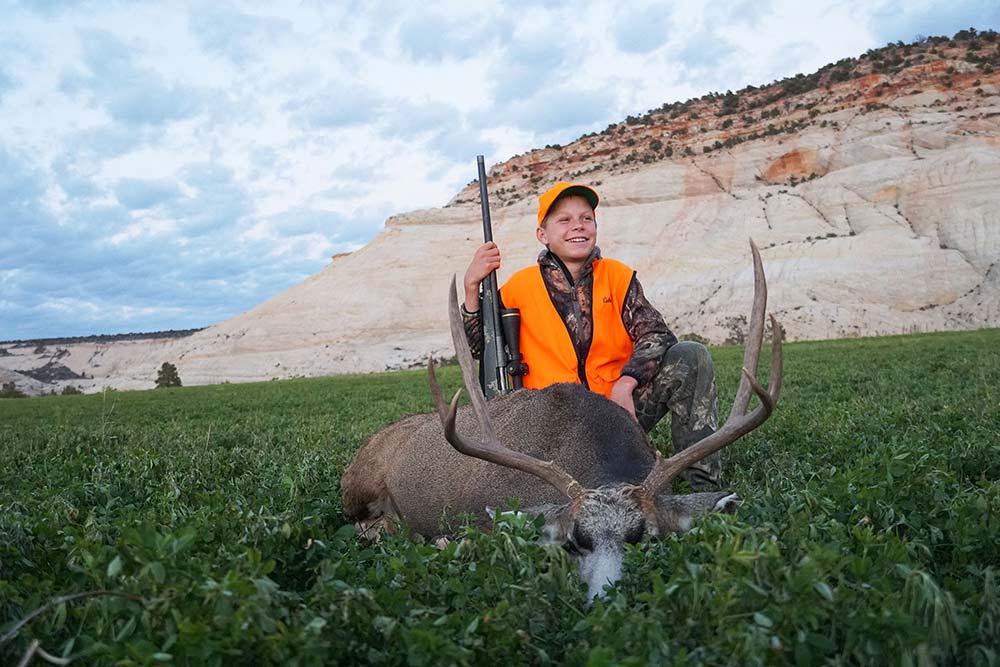
We pull my old Dodge into the field, load the buck, and take him home to skin and process. Ivan’s enthusiasm is infectious as his brother and sisters gather around to congratulate him. An hour later, the buck is quartered and hanging in the woodshed to cool, and the backstraps, tenderloins, and trim meat rests on ice. Ivan has already set the antlers in a place of honor. —A.V.B.
Read Next: How to Bivy Hunt for Giant Public-Land Mule Deer
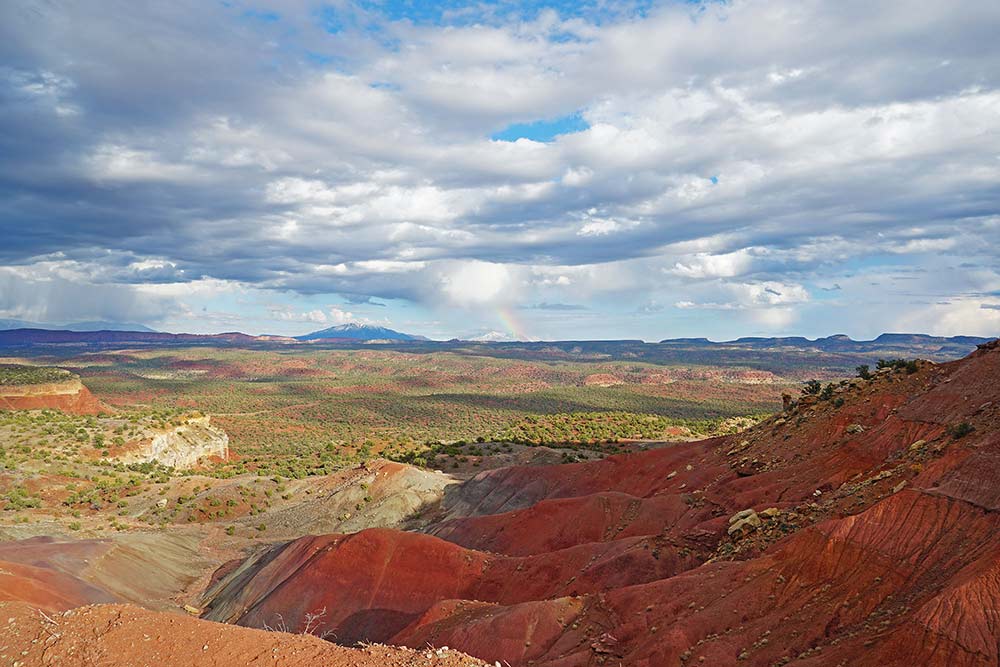
The Big 4-Point
This hunt has been a long time coming. It took me three years to draw a mule deer tag in southern Utah, followed by a flight to Salt Lake City, then a two-day wait in a rental car line (or at least it felt like two days), and finally, a winding drive through the mountains to Aram’s farm to meet his family.
Soon after, I’m climbing a haystack behind Aram and Josiah to glass a group of deer that are feeding in a neighbor’s field. I was raised hunting whitetails in the Midwest, so compared to the deer back home, all mature muley bucks look big. But there are two bucks that truly stand out: one is a wide 3×5 (which Ivan eventually misses on opening morning), and the other is a heavy 4×4 that has been running with a band of other bucks. I would actually call this deer a 10 pointer, but westerners call him a 4-point, because its got 4 points on either side and no credit for his brow tines.
After Ivan kills his deer, it’s my turn to hunt. The wide 3×5 has become a ghost. We spot him once before legal shooting light but he disappears up the mesa before the sun ever reaches the horizon. So, Aram and I take treks into the desert to look for bucks away from the farm. Unfortunately, southern Utah endured an epic drought last summer and areas Aram says typically grow lush grazing grass are now barren.
The landscape is vacant and stunning. We reach a pull off and see a rainbow rising over a red-rock valley that stretches up to a backdrop of purple mountains. I jump out of the truck to snap some photos, just like a tourist. The only difference between them and me is they’re not wearing blaze orange vests.
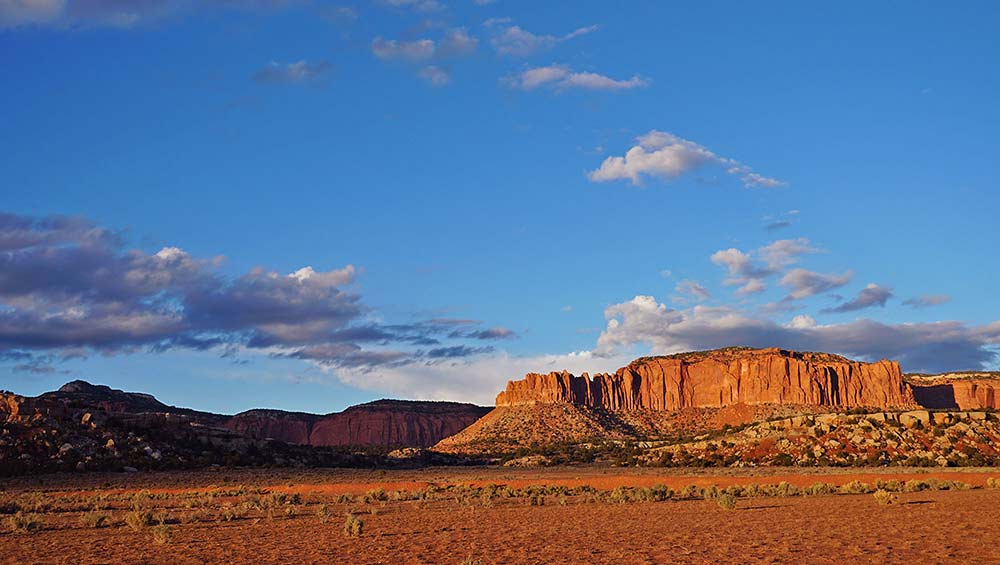
The heavy-racked 4-point is still lurking around the farm and Aram, his youngest son Josiah (10), and I agree it should be our target buck.
So, the next morning we climb the same mesa where we chased the 3×5 and spot a little band of bucks slipping up the same ridge.
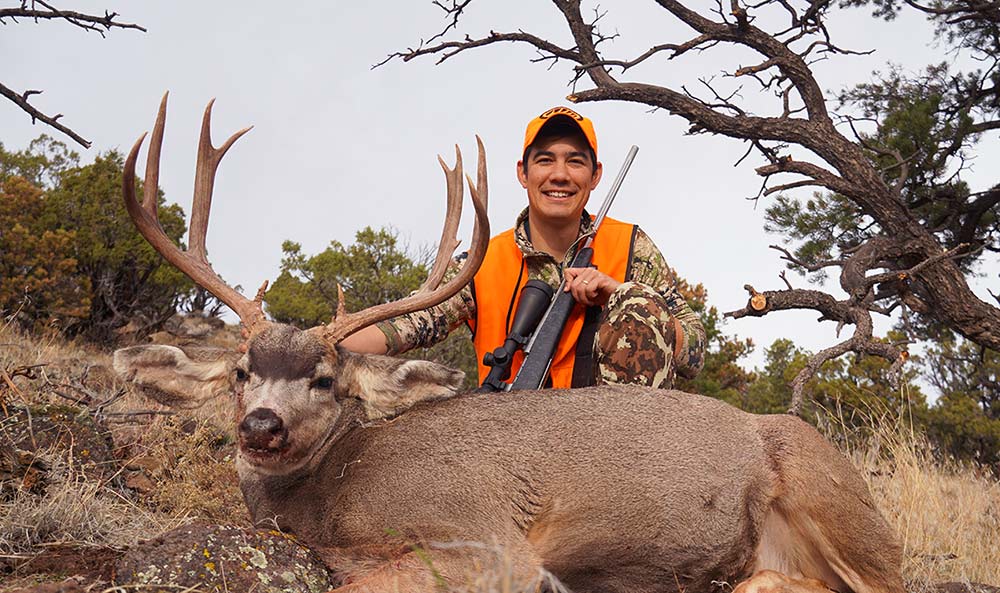
The deer are just 200 yards away, but they disappear and reappear around stands of juniper and sage. We start recognizing bucks from the band that we’ve seen before. There’s the half-rack, and the buck in velvet … but where’s the big buck? Josiah eventually finds him with a spotting scope and excitedly whispers, “There he is!” before calling out landmarks so I can find him with my riflescope.
I see through my scope the deer is certainly the big 4-point, but then quickly move the reticle away from the antlers and toward the buck’s shoulder, fighting my nerves the entire time. The buck stops and slightly quarters away. The gun goes off.
I lose sight of the buck in my scope, but Josiah stays on him. “He’s down,” he says and we’re equally excited now. We skin and quarter the buck on the mesa and haul the meat and rack back to the house in our backpacks.
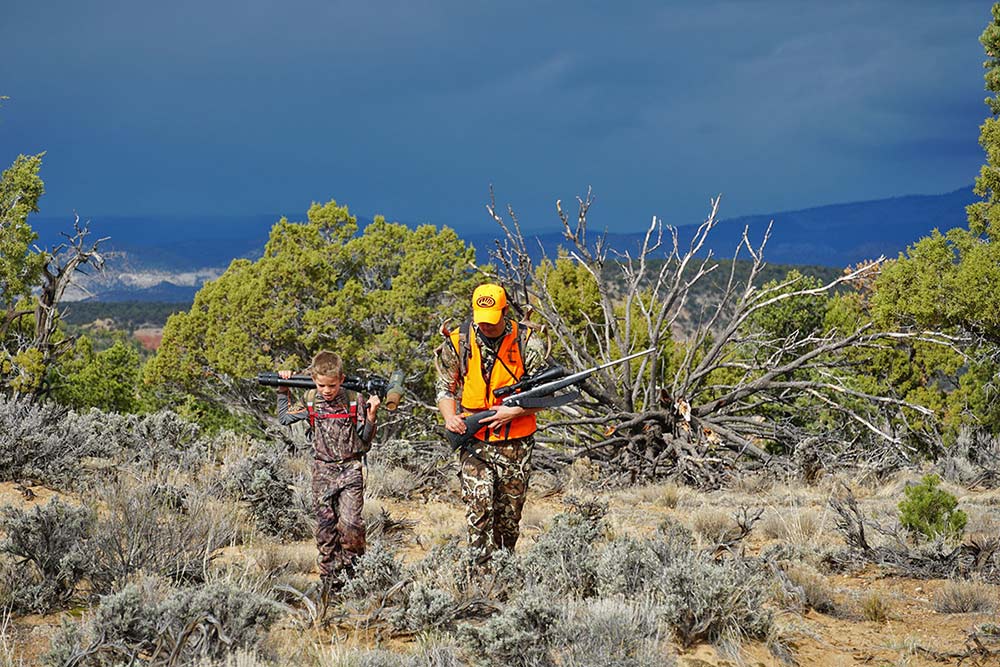
As we’re loading our packs, a wry smile rises across Josiah’s face, and he tells me, “I’ll carry the antlers back if you want.”
Even at 10, the young outdoorsman in training knows that it’s a point of pride for a hunter to pack his own buck off the mountain.
But before I can answer, Aram cuts in with, “Your time will come Josiah.”
I’m certain he’s right. –A.R.
